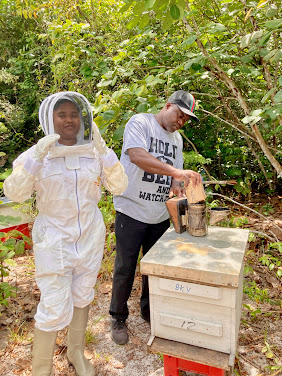Update from the Field: Water Security and Ecotourism on Old Providence Island, Colombia
F2F volunteers Femke Oldham & Matt Freiberg are currently in Colombia on a flex assignment. Here they share some of their experiences so far from their trip:
We are stationed in the archipelago of San Andres,
Providencia, and Santa Catalina Islands in the western Caribbean. These islands
are Colombian territory; however, they represent a melting pot of Latin
American and Caribbean cultures. We are working with the native island
community, called the Raizal, who are descendants of African slaves brought
over by European settlers about 200 years ago. The primary language of the
Raizal is a type of creole, and most people also speak Spanish and Standard
English.
 |
| F2F volunteers, Femke Oldham and Matt Freiberg on the "Peak" |
To date, we have completed the first four of our
assessments, which include measuring the available catchment areas (rooftops)
and taking stock of existing gutters, downspouts, and storage tanks, which
range from 50-gallon barrels to 25,000-gallon cement cisterns built underground
below the posadas (imagine a flooded basement). So far, our common
recommendations are for posada owners to install additional storage tanks,
gutters to transfer rainwater to their existing cisterns, or to plumb their
existing cisterns to feed their showers and toilets. We are also making more
simple recommendations such as installing screens over open water sources to
prevent mosquitoes and stronger gutter-downspout connections. We are working on
individualized reports for each posada to help the owners incorporate these
enhancements and design a system that will meet their specific needs.
 |
| Femke speaks with a posada owner during a rainwater assessment |
We found an abandoned vivero (plant nursery) and learned
that it had been actively managed by local Raizal farmers to restore and
maintain forested areas along the Peak trails until funding from the local
environmental protection agency dried up. We will likely incorporate a plan to
revive this nursery into our strategic planning document. More specifically, we
are looking into the potential for volunteer maintenance of the nursery or
linking with the local secondary school.
 |
| From left to right: Matt Freiberg, Octavio Mow from the Providence Foundation, local guide Karen Livingston, and Femke Oldham |
.JPG)


.png)
Comments
Post a Comment